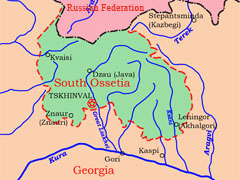South Ossetia: The violent thaw
By Asbed Kotchikian for ISN
On the evening of 7 August, Georgian forces launched a large-scale military operation against the unrecognized republic of South Ossetia, with the stated intentions of putting an end to what it views as a criminal regime. Within several hours, Tbilisi claimed that Tskhinvali - the South Ossetian capital - was in the hands of Georgian forces and that over two-thirds of the republic's territory was under Georgian control.
South Ossetia - formerly one of Soviet Georgia's three semi-autonomous regions, along with Abkhazia and Ajaria - declared itself independent of Georgia and under Russian jurisdiction in 1990, even before the collapse of the Soviet Union. According to official Soviet figures, in 1989 two-thirds of the region's population was Ossetian, the remainder ethnic Georgian.
In the last 15 years, numerous failed attempts were made by successive Georgian governments to bring the region back into Tbilisi's fold. Meanwhile, South Ossetia transformed itself into an unrecognized republic and developed closer ties with North Ossetia (a semi-autonomous region in the Russian Federation) and with Russia proper, to a point where today, according to some estimates, over 70 percent of South Ossetians have Russian citizenship.
The importance of South Ossetia to Russia is amplified as the region is close to Chechnya and to the infamous Pankisi Gorge, which Russia considers to be the main training grounds and supply line for Chechen separatists. Russian allegations of lawlessness in the region resulted in Moscow blaming Tbilisi for turning a blind eye to the free movement of Chechen fighters and military equipment in the Pankisi Gorge.
During most of 8 August, Georgian forces were staging attacks against South Ossetian positions, and the Russian retaliation was swift. Russian President Dmitry Medvedev called a government meeting and soon after Russian bombers targeted Georgian military positions in South Ossetia, Gori, Tbilisi and the coastal city of Poti. By Sunday, 10 August, Russia had managed to pour enough troops into South Ossetia to tilt the balance in their favor and reclaim complete control over Tskhinvali.
Meanwhile Georgian President Mikhail Saakashvili called for a ceasefire on Sunday evening, claiming that Georgian troops had completely left South Ossetian territory in an effort to spare civilian and military lives. The exact position of the fighting as well as the number of causalities is very difficult to estimate as there are no independent sources to verify the claims made by both sides.
While the escalation of the conflict was sudden, it was not unexpected that sooner or later Russia and Georgia would engage in a large-scale armed conflict as the tension between the two countries has been constant, particularly since Georgia's 2003 "Rose Revolution."
Saakashvili developed a foreign policy very close to the West with the aim of integrating Georgia into NATO and the EU, all the while openly antagonizing Russia. Moscow met this growing defiance with threats to do everything possible to protect South Ossetia and Abkhazia.
While Russia promotes itself as a mediator and has sent troops to the region under the guise of peacekeepers, Georgia claims that Russia is supporting breakaway regions in Georgia in retaliation for Tbilisi's increasingly pro-western policies.
While the international focus has been on South Ossetia, Abkhazia staged its own limited military operations against Georgian troops in the breakaway region and specifically in Kodori Gorge. Furthermore, the Abkhaz leader, Sergei Bagapsh, has claimed that Abkhaz volunteers have found their way to South Ossetia to help fight against troops sent from Tbilisi.
On the Georgian side, the escalation of the conflict can be traced to two major issues. First, in the last year or so, Saakashvili has been under intensifying pressure from within Georgia to deliver on the socio-political and economic reforms promised by the Rose Revolution. To this end, he has attempted to divert attention and boost his ratings through nationalistic rhetoric and actions. An all-out invasion of South Ossetia could be placed within that context.
Secondly, over the last few years, Tbilisi has taken more serious measures toward integration with western security institutions, including NATO's Partnership for Peace program and the US-led Georgia Train and Equip Program, which in turn has given Saakashvili a false sense of confidence that the West would support Georgia unconditionally in its standoff against Russia.
Russia, for its part, is intent on showing that it is not in the least hesitant to use force to back up its words, and to demonstrate Moscow is willing to protect its citizens in both unrecognized republics. Russia has also been swift to respond to the crisis militarily in an effort to show the world that the new Medvedev administration is just as tough as that of Vladimir Putin.
Incidentally, now-Prime Minister Putin was the first to react to the crisis while in Beijing attending the opening ceremonies of the Olympic Games, and soon after he visited North Ossetia to keep a closer eye on developments.
While the armed conflict seems to be heading toward another stalemate, with Georgia declaring a ceasefire and its readiness to initiate talks with Russia, the future of the region is as uncertain as ever.
One thing, though, is clear: Any chance that Georgia had to regain control over South Ossetia is now diminished and Russia has shown that it is willing to risk a war to maintain the status quo in its near abroad.

